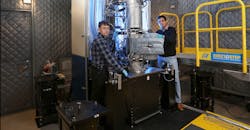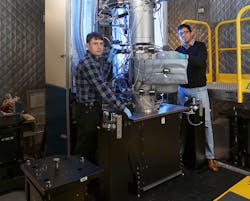Spectrometer Takes the Temperature of Nano-sized Material Samples
A scientific team at the DoE’s Oak Ridge National Laboratory has devised a new way to take the local temperature of a material from an area about a billionth of a meter wide. This should let engineers and scientists better understand the unusual physical and chemical behaviors that are occurring at the nanoscale level. In turn, this should advance microelectronic devices, semiconducting materials, and other technologies whose development depends on mapping atomic-scale vibrations due to heat.
The study used a technique called electron energy gain spectroscopy in a newly purchased, specialized instrument that generates images with high spatial resolution and great spectral detail. The 13-ft-tall instrument, made by Nion Co., is named HERMES, short for High Energy Resolution Monochromated Electron energy-loss Spectroscopy-Scanning transmission electron microscope.
The device takes advantage of the fact that atoms are always shaking, and the higher the temperature, the more they shake. The researchers used HERMES to measure the temperature of semiconducting hexagonal boron nitride by directly observing the atomic vibrations that correspond to heat in the material. The team included partners from Nion (developer of HERMES) and Protochips (developer of a heating chip used for the experiment).
Andrew Lupini (left) and Juan Carlos Idrobo use ORNL’s new monochromated, aberration-corrected scanning electron microscope to take the temperatures of extremely small portions of an object. (Credit: Jason Richards, ORNL)
“What is most important about this ‘thermometer’ is that it does not need calibration,” says Juan Carlos Idrobo, a physicist at ORNL. Most other thermometers require prior calibration. To make temperature marks on a mercury thermometer, for example, manufacturers needed to know how much mercury expands as the temperature rises.
“But HERMES gives direct measurements of temperature at the nanoscale,” says Andrew Lupini of ORNL’s Materials Science and Technology Division. “The experimenter needs only to know the energy and intensity of an atomic vibration in a material, and both are measured during the experiment.
These two parameters, when depicted as peaks, are used to calculate a ratio between energy gain and energy loss. “From this we get a temperature,” Lupini explains. “We don’t need to know anything about the material beforehand to measure temperature.”
In 1966, two researchers demonstrated electron energy gain spectroscopy, at a larger-length scale, and pointed out that the measurement should depend on the sample’s temperature. Based on that theory, the ORNL team hypothesized it should be possible to measure a nanomaterial’s temperature using an electron microscope with an electron beam that is “monochromated” or filtered to select energies within a narrow band.
To experiment with electron energy gain and loss spectroscopy, scientists place a sample in an electron microscope. The microscope’s electron beam goes through the sample, with most electrons barely interacting with the sample. In electron energy loss spectroscopy, the beam loses energy as it passes through the sample, whereas in energy gain spectroscopy, the electrons gain energy from interacting with the sample.
“HERMES lets us look at very tiny energy losses and even very small amounts of energy gain by the sample, which are even harder to observe because they are less likely to happen,” Idrobo says. “The key to our experiment is that statistical physical principles tell us it is more likely to observe energy gain when the sample is heated. That is what let us measure boron nitride’s temperature. The ability to probe physical phenomena at these tiny scales is why ORNL bought HERMES.”
Nanoscale resolution will let researchers measure local temperatures during phase transitions in materials, which is impossible with techniques lacking the HERMES’ spatial resolution. IR cameras, for example, are limited by IR’s wavelength to much larger objects.
In this experiment, scientists tested nanoscale environments at room temperature to about 1,300⁰ C (2,372⁰ F). HERMES could be useful for studying devices working across a wide range of temperatures, from electronics that operate under ambient conditions to vehicle catalysts that perform at over 300⁰ (600⁰ F).


